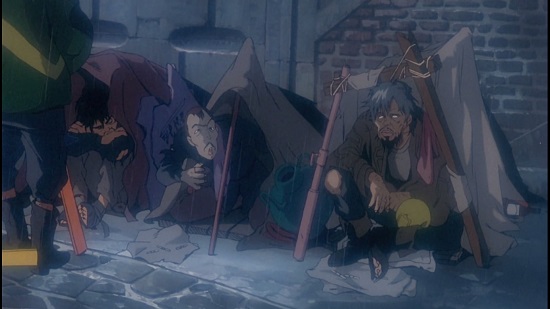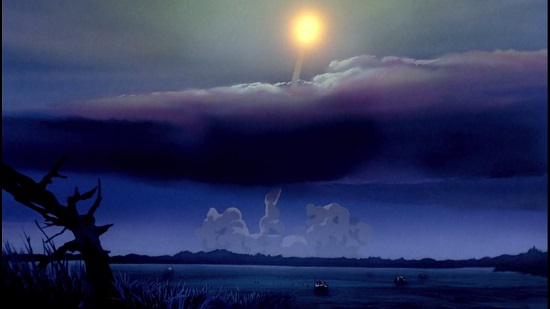"Suppose that life was a story. If you were to think about it like that… Have you ever wondered if maybe you aren’t a good guy? That you’re one of the bad guys instead?"
These are the inarticulate doubts of our protagonist Shiro, who wants to be the first man in space. Matti, his best friend and comrade, sidesteps the morality of the question, answering instead that everyone has their place and function in the world. We must all be needed for something, otherwise we wouldn’t be here at all. It’s possible that this small exchange is the first time Matti and Shiro have voiced a philosophical thought. Shiro in particular seems barely post-adolescent, and it’s only now that their lives within the Royal Space Force have taken on a wider significance than just goofy, rough-and-tumble sixth-form stuff. But their musings are interrupted by a gunshot, and the ensuing street chase launches the third act of Wings Of Honneamise with stylish, frenetic aplomb.
In hindsight it’s tempting to say that Wings bears evidence of its creator’s youth. Hiroyuki Yamaga was only 24 years old when he helmed this hugely ambitious film – the highest budgeted anime ever, at the time. There’s an abundance of themes and a curious mixture of tones, and it reminds me of the old truism about an author’s first novel often being overstuffed with ideas, eagerness, and a ‘style’ that signals itself too clearly. But then again, this isn’t literature, it’s anime: a medium most suited to denseness of detail, wide expressiveness, and world-building from scratch. Yamaga constructs the hugely ambitious alternate-present in Wings Of Honneamise as if he might never get another chance to imagine something of this scale in a feature film. And as it turned out, he didn’t.

What’s amazing about Wings is that it’s so incredibly close to being a total success. It’s not quite up there with Nausicaä Of The Valley Of The Wind (1984), the second Miyazaki feature and among the finest and most influential films ever to come from Japan, but it is probably on par with Akira, which followed it by a year in 1988 and quickly became the quintessential ‘serious’ anime film. Nausicaä didn’t so much open the door to anime’s possibilities as blow it off the hinges, and these three together represent the culmination of the form’s development throughout the 1980s. Not just artistically but also commercially: each exceeded the previous films’ record production budget and attempted to set the new highest standard. And yet Wings Of Honneamise wasn’t a domestic hit at the time, and it took longer still to establish itself in the West. It deserved better.
In Yamaga’s version of Earth, mankind has not yet travelled in space. That’s quite a bold move for a form so suited to depicting fantastical advancements in technology. (And in contemporary American live-action cinema, we’re post-Star Wars, post-Alien, and perhaps more influentially, post-Blade Runner.) With this setting Yamaga strives to remind us how incredible space travel (and flight in general) actually is, and this aspect of the film is an unqualified success. The aerial sequences in Wings are visually remarkable: the colour tones in the sky, the perspectives of the ground and the horizon, the weightless play of the ‘camera’ above the clouds. It’s top-drawer art direction, storyboarding, editing, you name it. Shiro’s first experiences of flight feel almost as revelatory to us as to him.
However, most of the citizens of the Kingdom of Honneamise are less than thrilled with such intrepid stuff. There is real hardship and poverty in this society, and the space program is deemed by most to be a fanciful waste of money and effort. The Air Force is particularly scornful of the Space Force cadets, and government funding is being repeatedly slashed. When Shiro volunteers for the Royal Space Force’s first manned flight, everyone thinks he’s insane. Previous attempts have proven disastrous; surely this is a suicide mission. But Shiro is dead set on heroics. An encounter with a young woman handing out religious pamphlets has awakened in him the sense of a greater purpose: he transforms from a young slacker into one of mankind’s bravest explorers, the public face of technological advancement and human mastery over its environment.

Of course, this is not all as it seems. Shiro comes to realise that his image is being sold to a divided populace as a figure of hope, only to mask the hidden machinations of private industry and an aggressive foreign policy. On his way to a photo shoot in an echoing, temple-like municipal building, he walks past a line of beggars crowding the steps. He is bored by the publicity game, confused and exhausted by its political implications; he leaves quickly and tosses a handful of change on the steps. Riquinni (the sad, earnest pamphleteer) has stirred in him a sense of adventure as well as a sense of society’s moral bankruptcy, but he is still too young and fickle to understand either in great depth.
She’s also stirred his sexual frustration, and in an alarming turn of events he attempts to rape her. This comes out of practically nowhere: we expect he might have romantic designs that are thwarted by her religious devotion, but his violent eruption is a surprise that sours our relationship with him. Up to that point, he’s been a goofy, slightly frustrating protagonist; his naivety and unreadiness to be a public hero has been his character arc. But his capacity for violence (and not of the cartoony, chase-scene kind) reveals a deep and brutal flaw. Though Riquinni brushes his culpability aside, we see that her warnings about the sinful conduct of modern society also extend to Shiro.
All of which adds darker shade to Shiro’s comments about being "one of the bad guys" in the next scene, though he’s ostensibly talking about his position as a pawn in a political game. Wings Of Honneamise asks some pretty big questions about human endeavour, and how we justify striving for advancement while there is still so much suffering and corruption in the world. Ultimately, with all the malign forces raging and racing below him, Shiro is able to leave it behind, and from a great distance we share with him a perspective that takes in the whole grand sweep of human history.

This is Hiroyuki Yamaga’s bold first shot at a huge artistic statement, and it very nearly comes off. That said, it still achieves more than most films attempt and should be required viewing for anime fans worldwide. It doesn’t have the warmth and strangeness of Miyazaki’s greatest crossover successes, but its art direction and weighty themes are memorable. A sequel called Aoki Uru was planned but never came to fruition, as the production studio struggled to fund the project. Two core members of the design and animation team, Hideaki Anno and Yoshiyuki Sadamoto, would work together again on the hugely popular series Neon Genesis Evangelion. And after three decades of periodic attempts at restarting the Wings sequel, Yamaga’s Aoki Uru is finally slated to appear some time in 2018.


